![]() MARK GARDINER (with help
from Neil Mackenzie)
MARK GARDINER (with help
from Neil Mackenzie)
![]()
Day Seven - Friday 25 May
Another sunny day for our tour of the cemeteries to the north-east of Ypres, mostly the battlefields of 1915 & 1917. This area contains some small battlefield or "comrades" cemeteries as well as the much larger concentration cemeteries formed around existing burial grounds where graves from isolated spots or smaller cemeteries that were closed after the Armistice were moved.
We started at La Belle Alliance Cemetery which is a small cemetery (60 graves) set in the middle of fields; the cemetery register is held in nearby Divisional Collecting Post Cemetery. We were visiting: -
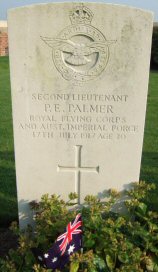 |
Second Lieutenant Percy Palmer of 29th Squadron, Royal Flying Corps, who was born in Parramatta, New South Wales, and was a motor engineer with five years spent in the Royal Australian Navy Reserve when he enlisted in Petersham in January 1915 in the 1st Bn. Australian Infantry. He was wounded in France in June 1916 by shrapnel to the head and right side of the chest, before being detached in October 1916 for duty with the R.F.C. Commissioned in the R.F.C. (and released from the A.I.F.) in March 1917, he joined the 29th Squadron flying Nieuport Scouts from Poperinghe Aerodrome, but within a few days was shot down and killed on 17 July 1917 aged 20, his aircraft crashing within the Allied lines. |
Private John Thomson of 1st/7th Bn. Argyll & Sutherland Highlanders from Paisley, who died on 3 August 1917 aged 25.
Just a short distance away is the larger Divisional Collecting Post Cemetery & Extension, originally formed by divisional field ambulances. Most of the headstones are heavily weathered and pitted. We were visiting: -
Lieutenant Dennis Meirville Crew of 7th Bn. Cheshire Regiment from Macclesfield, who was born in 1895 and attended Shrewsbury School. A silk finisher who enlisted in October 1914, he was found unfit for military service whilst in Cairo in April 1916 with rheumatism, although a military board reversed that verdict in September 1917. He was reported missing on 5 July 1917 and his identity disc was returned from Germany; he had been buried by the Germans in Westroosebeke Communal Cemetery, and as his grave was later destroyed he is commemorated by a special memorial.
Corporal Joseph Saich of 2nd Bn. Essex Regiment who hailed from Romford, although his widow was recorded as living in East Molesey in Surrey. It was the 89th anniversary of his death, aged 36, on 25 May 1918. The day before the Battalion had suffered a very heavy gas attack and bombardment before retiring to an area between Shell Trap Farm and the canal bank, where they suffered some more casualties the following day; it is possible Cpl. Saich was amongst the wounded reported following the German attack the day before he died.
A little further down the road is New Irish Farm Cemetery, a large burial ground containing over 4,700 graves of which the vast majority were concentrated after the Armistice, so there are many unknown soldiers resting here. It is perfect condition, which is more than can be said for my camera as the battery finally gave up, and the gardeners and pet cat were in early attendance. We were visiting: -
Private Arthur Hargreaves of 7th Bn. Border Regiment, whose family lived (and he is commemorated) in Great Harwood, Lancashire. He died aged 30 on 29 September 1915.
Lieutenant Denis Philby of Royal Dublin Fusiliers, whose family came from Camberley, Surrey. He was sent to France in August 1914 and was attached to the 2nd Bn. Royal Munster Fusiliers, who were in the front line at Brown Road (believed to be near Hooge) on 12 November 1914; He was killed aged 25 during enemy attacks.
Heading north we came across the tiny battlefield cemetery of No Man's Cot Cemetery, set in the middle of ploughed fields that were being sprayed when we arrived. Parking is difficult here and there is no registry box. Most casualties buried here were suffered on 31 July 1917 on the opening day of Third Ypres, including Private Arthur Ewen of 10th Bn. Welsh Regiment, whop was one of six brothers from Seven Kings in Essex who all served. When attesting in the Army Pay Corps in May 1915 he gave his age as 20 (although this is his age at death as recorded by CWGC), and although rated C3 (later revised to B3) and having reverted back to Private after disciplinary problems, he was transferred to a Training Reserve Battalion in Aldershot before joining the Welsh Regiment in May 1917 for active service.
A very similar cemetery can be found in Welsh Cemetery (Caesar's Nose) - tiny, in the middle of ploughed fields, reached via long grass pathways under the eyes of inquisitive cows. There is no registry box but a local information panel has been mounted which is very impressive in content. Named after the 38th (Welsh) Division that started burials here, it includes Lance Corporal Frederick Sheldrick of 15th Bn. Royal Welsh Fusiliers, who was a 19-year old clerk from Caledonian Road, London, when he enlisted in the 18th Bn. Royal Welsh Fusiliers in July 1915. Sent to France in December 1915, he as promoted to unpaid Lance Corporal before being arrested in September 1916 for leaving his post without orders from a superior officer. Found guilty by a general courts martial on 5 October 1916 he was sentenced to 12 months hard labour and was imprisoned at Le Havre, before in November 1916 the Commander-in-Chief remitted the unexpired portion of his sentence for gallant conduct, and he was transferred to the 15th Bn. He was killed in action on 27 July 1917 aged 20.
Colne Valley Cemetery is another small battlefield cemetery (no registry box) set amongst trees on the edge of an industrial estate. We were visiting Private John Aked of 1st/5th Bn. Duke of Wellington's (West Riding Regiment) from Halifax who attested and was embodied in October 1914. Arriving in France in April 1915, he was killed aged 20 on 14 August 1915. Neil - can you check your notes as you quote the war diary for May 1915.
| It was difficult to park at our next objective, in part due to the muddy ground conditions (despite the sun), which was Dragoon Camp Cemetery, another small battlefield cemetery (again no registry box) in the middle of field reached by long grass chemins. We were visiting Lieutenant Thomas Nicholls-Jones of 14th Bn. Royal Welsh Fusiliers, another who died on 31 July 1917 at the opening of the Passchendaele offensive. His family came from Llangefni, Anglesey, and he enlisted in the Public Schools Battalion of the Middlesex Regiment in September 1914, before being commissioned into the Royal Welsh Fusiliers in December 1914. Aged 30 he was acting at the Battalion Transport Officer when he was killed at Villa Gretchen, near Pilkem (?), whilst bringing up rations. | 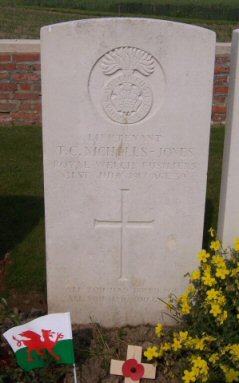 |
A different sort of burial ground was next, the concentration cemetery of Artillery Wood Cemetery, which was quiet and peaceful except for a lot of birdsong, and well kept with the flowers in full bloom. We were visiting: -
Private Sidney Foster of 15th Bn. Welsh Regiment, from South Norwood, London, who attended Whitgift Middle School. He was another who lost his life on 31 July 1917, aged 28.
Private Charles Jelfs of 2nd Bn. Royal Fusiliers, from Denby, Huddersfield, who died aged 20 on 13 July 1917, and who is commemorated on the Midland Bank War Memorial.
Lieutenant John Pengelley Bibby of 1st Bn. Grenadier Guards, who was born in Woolton, Liverpool, and was a member of the Eton School Corps. His family lived in Hyde Park Street, London, and he was an insurance clerk before enlisting in the 18th Bn. Royal Fusiliers in September 1914, before being commissioned into 4th Bn. Grenadier Guards in April 1915. He returned to England on sick leave with severe trench fever in June 1916, and attended regular medical boards until he was ruled fit for active service in February 1917. Commanding No.3 Coy. of 1st Battalion he was killed on the morning of 12 October 1917 during an advance across the western edge of the Vijwegen spur towards the edge of Houthulst Forest, which was met with a heavy German barrage of gas shells. He was 27 years old.
Gunner Alan Eatough of 'D' Bty. 75th Brigade, Royal Field Artillery, from Great Harwood, Lancashire, who died on 13 October 1917 aged 22.
Cement House Cemetery is another large concentration burial place, but sited on the side of the busy road towards Langemark. There have been recent interments here, as the turf has not yet been laid over the graves and the concrete foundations of the headstones are visible. The gardeners were hard at work again, and there were plenty of beautiful rose bushes. We were visiting: -
Private William Palliser of 2nd Bn. South Wales Borderers, from Great Harwood, Lancashire, who died on 7 October 1917 aged 31.
Captain The Honourable Patrick Ogilvy MC of 1st Bn. Irish Guards, the son of the 10th Earl of Airlie (killed in the Boer War) who was born on 25 June 1896 at Cortachy Castle, Kirriemuir. He had passed the entrance exam to Christ Church College, Oxford, when he enlisted as a Private in the Fife & Forfar Yeomanry on 3 August 1914, where he was soon commissioned as a Second Lieutenant. Applied for commission in Special Reserve of Officers which he had joined September 1914 and left on 2 October 1914 for "private reasons" before being commissioned in the Irish Guards in June 1915. He was awarded the Military Cross for action at Lesboeufs on the Somme on 25 September 1916: "For conspicuous gallantry in action. He led his company with great dash, and, on reaching the final objective, was the senior officer in the front line. He dealt with a difficult situation with great skill and determination, consolidating his position, and getting into touch with the battalions on his flanks. All this was carried out under heavy shellfire." Commanding No.1 Coy. on the night of 8/9 October 1917 when they were involved in an attack from Ruisseau Farm against Houthulst Forest, he was one of the company commanders who was killed, aged 21.
Ruisseau Farm Cemetery is very isolated, shut away behind a farm (you park in the yard) and is another small battlefield cemetery that is seldom visited. Buried there is Second Lieutenant Ralph Babington of 3rd Bn. Coldstream Guards from Coulsdon, Surrey, who attended Whitgift Grammar School and Sandhurst, where he was still in attendance when nominated for a commission by a Colonel of the Coldstream Guards. He was killed aged 19 on 9 October 1917 along with a number of his platoon on a road going up to a position for an attack in the early morning (possibly that in which Capt. Ogilvy perished), and was buried by the Guards Divisional Burial Party - the 4th (Pioneer) Bn. Coldstream Guards.
In contrast to most of the cemeteries and memorials that we visited, Langemark German Military Cemetery always looks gloomy, although a little less so in the bright sunshine; the four statues at the back seem less foreboding.
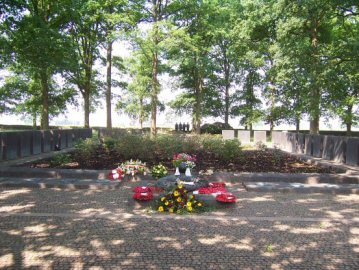
There is a new minimalist visitors' centre and car park. The two British casualties both died whilst prisoners of war, and are buried in the mass grave just inside the entrance; ironically the brass plaque naming them installed by the CWGC (in consultation with the VdK) shows up more than all the names of the German casualties. They are: -
Private Albert Carlill of 1st/4th Bn. Loyal North Lancashire Regiment from Brough, Yorkshire. The 55th (West Lancashire) Division did not arrive in Belgium until November 1918 and he died as a prisoner of war on 4 November 1918 aged 19, and was originally was buried in Louvain Communal Cemetery, presumably near or among German graves and included with other German bodies when they were moved to Langemark. Because presumably his grave could not be located in the cemetery, he was originally commemorated by CWGC on a special memorial behind the Cross of Sacrifice at Cement House Cemetery.
Private Leonard Lockley of 4th Bn. Seaforth Highlanders, although some records show him as serving with the 7th Bn. From Portsmouth, he died on 30 October 1918 whilst a prisoner of war.
Continuing along the road through the village of Poelcapelle is another large concentration burial ground at Poelcapelle British Cemetery which is again well-maintained and there is some renovation work being carried out replacing the grass around some plots. We were visiting: -
Private Ralph Torrome of 2nd Bn. Scots Guards, who died on 19 April 1916. His original grave marker is present in a photograph of Potijze Chateau Grounds Cemetery; perhaps it was just being stored there after the permanent headstone was raised here.
Able Seaman Alfred Galloway of Anson Bn.. Royal Navy Division, a member of the R.N.V.R. from Leighton Buzzard, Bedfordshire, who had joined up in May 1915, and seen service in France before being hospitalised with influenza and scabies in late 1916. A member of the Machine Gun Coy. he was originally reported as being wounded on 26 October 1917 in the fighting around Varlet Farm, before being officially recorded as wounded and missing; in June 1918 it was suumed he had been killed in action on 26 October.
Lance Corporal Charles Johnson of 28th Bn. London Regiment (Artists' Rifles) who attended Whitgift Grammar School 1896-99. Enlisting in August 1914, and seeing action in France in 1915 & 1916, he was reported missing on 30 October 1917 aged 34. He was exhumed from his original grave and reburied here.
Lieutenant Cyril Shakespear Beachcroft of Household Bn., who had attended Charterhouse School, been a member of the Inns of Court OTC in 1909-12, and was married and living in Wimbledon. He rejoined his old OTC in August 1914 and was commissioned as a Second Lieutenant in the Dorset Yeomanry in October 1914, before transferring to the Household Battalion as a temporary Lieutenant on 1 July 1917. He died on 12 October 1917 aged 32.
Another concentration cemetery, set on a slope falling away from the road so it is larger than it first appears, is Passchendaele New British Cemetery. Buried here is Lance Corporal William Tomlinson of 45th Bn. Australian Infantry. Born in Ingleton, Yorkshire, in 1882 he had previously served four years in the militia and three years in the Territorials. He and his wife were living in Liverpool when she fell ill and left to a relative's house in Clapham, Yorkshire; he failed to send her the rail fare home, and she later moved into her mother's house in Accrington. They never reunited before he left for Australia in 1908 and became a railway cleaner. Enlisting in August 1915, Pte. Tomlinson arrived in France via Egypt and Marseilles, and was promoted to Lance Corporal barely a week before he was killed on 13 October 1917 at either Westhoek Ridge or Esplanade Sap, aged 35. Although he left everything in his will to his sister, his wife ensured he is commemorated on the Accrington War Memorial.
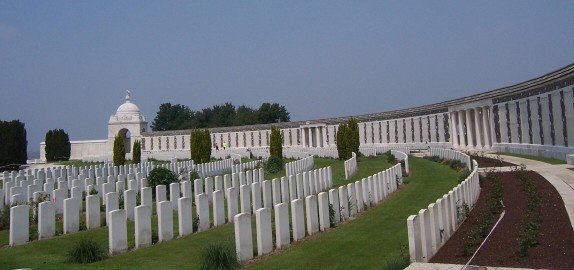
Our next stop was at the largest concentration cemetery of them all, Tyne Cot Cemetery. As usual I found myself overwhelmed by the sheer size of the cemetery and the walls of the Memorial to the Missing. CWGC staff were hard at work re-engraving headstones on site with air guns, and the ground was being prepared for a greater influx of visitors later this year for the 90th anniversary. There is a new visitors' centre and car park at the rear of the Memorial, although it is once again fairly minimalist in tone (there are no refreshments) but it does not impinge on the cemetery as we'd once feared. Buried within the cemetery are: -
Lance Corporal George Mann of 8th Bn. East Surrey Regiment, whose family came from Waddon, Surrey, and who had attended Whitgift Middle School. He died on 9 August 1917 aged 19.
Second Lieutenant Harry Bundle of 13th (Kensington) Bn. London Regiment, who had also attended Whitgift Middle School and whose family came from Croydon. He had enlisted as a Private in the 18th Bn. (London Irish) aged 19 in September 1914, and had been wounded in the left leg at Loos on 25 September 1915 in the attack which began with the London Irish kicking a football out into no man's land. He returned home, was commissioned into the 13th Bn. & returned to France in July 1917. Killed on 20 September 1917 aged 21 he was originally buried in an isolated grave about one mile south-east of St. Julien until: "In accordance with the agreement with the French & Belgian governments to remove all scattered graves and small cemeteries containing less then 40 graves, and also certain other cemeteries which were situated in places unsuitable for permanent retention, it has been found necessary to exhume the bodies [and his body has been] removed and reburied in Tyne Cot Cemetery.
Serjeant Thomas Dalziel of 28th Bn. London Regiment (Artists' Rifles) from Croydon, who attended Whitgift Grammar School and joined the Artists' Rifles in August 1914. He was killed on 30 October 1917, possibly in the same action which claimed the life of L/Cpl. Johnson who is buried at Poelcapelle.
One grave in Tyne Cot that has interested Neil is that of an unknown officer of the Queen's Own Oxford Hussars. Neil's research indicates that there are only two officer casualties for this unit with unknown graves: Capt. Brian Molloy, who died on 1 November 1914 and is commemorated on the Menin Gate; and 2/Lt. Harry Biedermann attached to 57th Squadron, Royal Flying Corps, who died on 10 August 1917 and is commemorated on the Arras Flying Services Memorial. Further reference to records strongly indicate that there is a high probability that the officer buried here is 2/Lt. Biedermann, as the location where the body was located rules out it being Capt. Molloy, whilst Biedermann was shot down between his base at St. Omer and the Houthulst Forest.
Commemorated on the Memorial to the Missing are: -
Private Horace Rowlinson of 2nd Bn. Northamptonshire Regiment, who was born in Duxford, Cambridgeshire, and had been with the Essex Regiment Territorial Battalion before transferring to the Northamptonshire Regiment. He was killed in action on 23 November 1917 aged 20.
Private George Langford of 1st/1st Bn. Herefordshire Regiment, who was killed in action on 4 September 1918.
Private Stanley Williams of 1st Bn. Devonshire Regiment, who was killed aged 34 on 4 October 1917. Already a widower, his orphaned children (a boy and a girl) spent several very unhappy years in the workhouse; the boy became the father of Neil's next-door neighbour.
A complete contrast is found at our next cemetery, the small and irregularly shaped but neat Polygon Wood Cemetery. A very recent burial (2004) here is Private John Thomson of 2nd Bn. Gordon Highlanders, whose remains were found in a garden in 1998. Born in Cowdenbeath in Fife, and living in Lochgelly, he had previously served with the Royal Highlanders (Black Watch) before being reported missing on 4 October 1917.
After a packed lunch, we crossed the road to the much larger Buttes New British Cemetery, Polygon Wood, which is set amongst the trees of said route, overlooked by the old musketry butt and the Australian Divisional Memorial, and with the New Zealand Memorial at the opposite end (which contains the cemetery register). Another concentration cemetery it is extremely peaceful being surrounded by the trees. We were visiting: -
Lieutenant Edward Bouskill of 21st Bn. Manchester Regiment from Barnhall Grange, Stockport, who had joined the Manchester University OTC in January 1915 before applying for a temporary wartime commission. He joined the 14th Battalion in September 1916 before suffering shrapnel wounds to his left hand at Beaumont-Hamel in November 1916; evacuated to Northumberland War Hospital at Gosforth, Newcastle-upon-Tyne, he'd developed trench fever and pains in his legs, before joining a training battalion at Ripon, finally joining the 21st Battalion in the field. On 4 October 1917 some companies of the 21st Battalion were attached to the 22nd Battalion, and were launching an attack from Polygon Wood as part of the Battle of Broodseinde; Lt. Bouskill was killed in action aged 21, although his body was not recovered at the time; he is believed to be buried in this cemetery.
Lance Corporal Norman Coles of 2nd Bn. Honourable Artillery Company, from Stoke Newington, London, who had enlisted in January 1916 and was originally posted missing, presumed dead on 9 October 1917 aged 21. His body was later exhumed and reburied here, along with many of his comrades from the same battalion.
Private Victor Fletcher of 2nd Bn. Honourable Artillery Company, from Twickenham, Middlesex, who had attested at Finsbury and was called up in March 1916.He was also posted missing on 9 October 1917, and his death was not confirmed until 15 November 1917, aged 20. As with L/Cpl. Coles his body was exhumed and reburied here.
The Buttes New British Cemetery (New Zealand Memorial), Polygon Wood, is in some need of cleaning, as the stonework is a little grimy and the names need re-pointing. Commemorated here is Rifleman George Skinner of 2nd Bn. New Zealand Rifle Brigade, a farmer from Kaco, Whangeroa, who didn't leave New Zealand until July 1917, arriving in Liverpool two months later. On 22 November 1917 he volunteered for a stretcher party to go out under an enemy barrage heading towards Black Watch Dressing Station when he was killed instantly by an exploding shell; he was 21 years old. His original grave was nearby, between Jerk House and Cameron House.
Dochy Farm New British Cemetery dates from after the Armistice and is a mid-sized concentration cemetery sited upon the position of a former German strongpoint, with good all round views, particularly across to Tyne Cot Cemetery. The grass needs some work as there are some weeds and daisies in the lawn. We were visiting: -
Second Lieutenant Edward Lovell of 5th Bn. Lancashire Fusiliers, born in Battersea, and a clerk who had originally enlisted in the East Surrey Regiment before joining the 2nd/28th Bn. London Regiment (Artists' Rifles) and later an Officer Cadet Battalion. Commissioned in the Lancashire Fusiliers in September 1917, he landed in France on 27 October 1917, and was killed in action aged 28 on 12 November 1917.
Corporal John Condry of 'C' Bty. 64th Brigade, Royal Field Artillery, from Church, Lancashire, who was killed on 11 December 1917 and is commemorated on the Accrington War Memorial.
Bridge House Cemetery was started by the 59th (North Midland) Division in September 1917 during the Battle of Polygon Wood. It is small (there is no registry box) but there are plenty of flowers in full bloom and the attendant bees. We were visiting: -
Private Fred Firth & Private Henry Jackson of 1st/6th Bn. Lancashire Fusiliers, who were both killed on 6 September 1917 following a failed attack on enemy positions at Beck House, Iberian and Kay.
Second Lieutenant Percy Labdon of 469th Field Coy. Royal Engineers, a student in civil engineering from Cullumpton, Devon, who had joined the 7th Devon Territorials in 1913 before being sent to France in December 1914, joining the 6th Coy. Army Cyclist Corps and later XIV Corps Cyclist Battalion. In January 1917 he returned to England and a engineering training centre at Newark, before being discharged to a commission which was gazetted in May 1917. On 26 September 1917 an attack was made by 59th Division; No 3 & 4 sections were attached to 177th Brigade for making strong points at Dochy Farm and vicinity. These sections were in position with carrying party of 100 men at 4am in vicinity of Delva Farm when they were subjected to heavy enemy bombardment, killing Labdon (aged 21) and L/Cpl. Stanley, who is buried in the next grave.
Based in a shady spot in the village of Sint-Juliaan is St. Julien Dressing Station Cemetery, which was also started in September 1917, but was added to after the Armistice, and there are more burials here than you would first think. Amongst them is Private Robert Kiely of 1st/28th Bn. London Regiment (Artists' Rifles), a clerk with Midland Bank from North Finchley, London, who had enlisted in February 1915 aged 35. On 30 October 1917 the Battalion attacked from Albatross Farm when the Germans dropped a counter-barrage 100 yards behind the British barrage, causing severe casualties in the mud near Source Trench, including Pte. Kiely. He is commemorated on London Joint City & Midland Bank Memorial in Canary Wharf.
On the road back towards Ypres, is Seaforth Cemetery, Cheddar Villa, which is unusual in that the vast majority of grave markers are arranged against the walls surrounding the lawn. Buried here are two subalterns from the same battalion, killed on the same day (25 April 1915): -
Lieutenant Alfred Burness of 2nd Bn. Seaforth Highlanders, whose family came from Haywards Heath, Sussex. He was the Battalion Machine Gun Officer who died of wounds aged 27 and was initially buried near Burnt Farm on St. Jean - St. Julien Road.
Second Lieutenant Arthur Cameron of 2nd Bn. Seaforth Highlanders, whose father was Reverend at St Andrew's Vicarage, Tain in Rosshire. Conflicting reports were made stating that he was wounded in the head and chest or stomach about 100 yards from the German trenches, and he was brought back to the dressing station at the farm where he died three hours later, aged 21. He was buried at the farm next to Major Arbuthnot and Lt. Burness, although if Cameron, Burness and Arbuthnot were buried next to each other and the first two are in grave A3 and Arbuthnot in grave A5, who is in grave A4?
Right opposite the start of the A19 motorway is Buffs Road Cemetery, which only adds to its isolation, although it is well maintained. Buried here is Captain Arthur Gray of 1st/1st Bn. Cambridgeshire Regiment. He attended Perse Grammar School in Cambridge where he had been in the cadet corps and OTC; a bookbinder by trade he had joined 2/1 Suffolk Yeomanry in October 1909 and extended for a further year in 1913, before applying for a commission in 1915. He was killed on 31 July 1917 on the first day of the Third Battle of Ypres.
Another small and isolated burial plot in the middle of the fields, although both well kept and visited, is Track "X" Cemetery, where Private Richard Hoar of 1st/1st Bn. Hertfordshire Regiment is buried. From Hemel Hempstead he worked at Dickinson's paper mills, he was also killed on 31 July 1917 (aged 23) when the Battalion was cut down by heavy machine gun fire.
Our final stop was at the very isolated but stunningly beautiful Minty Farm Cemetery. It is often said that Commonwealth military cemeteries are supposed to remind one of a typical English garden, and this cemetery is the supreme example, with an immaculate lawn and large numbers of flowers.
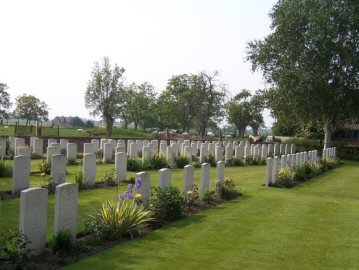
We were visiting Lieutenant James Cordner MC of 17th Bn. Royal Irish Rifles, from Lisburn, County Down. He lived at Drumbo Manse and had spent some time in Canada before returning to Ireland to study for the ministry. Although he became a minister in the United Free Church, Lisburn, he "volunteered for combat service" and was presented with a sword of honour by the congregation in June 1915. He did recruiting work while attached to 17th Bn. Royal Irish Rifles (a training battalion), and at a service in Whitehead on 23 July 1916, expressed the opinion that: "Ulster had done well but it could do better. There were still young men at home to whom the war had not yet appealed. They were still more concerned about the cut of their coats or colour of their ties, and they seemed to care little that the thunder of the guns was comparatively near their doors." He went to the front in 1917, was wounded in the summer and awarded the Military Cross for gallantry. He died on 16 April 1918, the same day his promotion to Lieutenant was gazetted, and left all his property to his fiancé Miss Bertha Templeton (of Strandtown, Belfast) who wrote to War Office in July 1918: "I shall be obliged if you will kindly inform me if I am entitled to the 'Blood Money' or if some will go to Lt. J Corner's father?" [The minister of Drumbo Presbyterian Church.] Their reply concluded:- "No such grant as 'Blood Money' has been authorised for issue by this Department".
We had covered 30 miles in about 8 hours.
| Continue reading the Salient Tour Account - DAY 8 |
![]()
 Copyright © Mark Gardiner,
March, 2008
Copyright © Mark Gardiner,
March, 2008
Return to the Contents Section